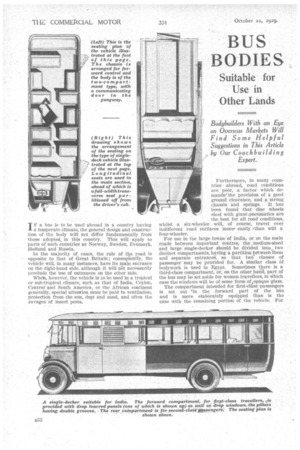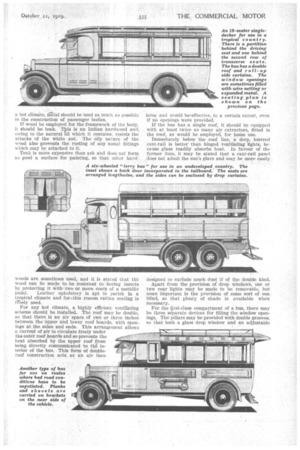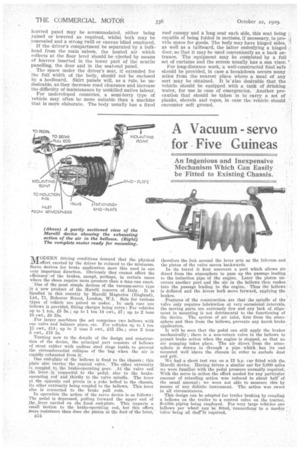BUS BODIES
Page 78

Page 79

Page 80

If you've noticed an error in this article please click here to report it so we can fix it.
Suitable for Use in Other Lands
Bodybuilders With an Eye, on Overseas Markets Will Find Some Helpful Suggestions in This Article by Our Coachbuilding Expert.
IFa bus is to be used abroad in a country having a temperate climate, the general design and construction of the body will not differ fundamentally from those adoptell„ in this country. This will apply to parts of such countries as Norway, Sweden, Denmark, Holland and Russia.
in the majority of cases, the rule of the road is • opposite to that of Great Britain; consequently, the vehicle will, in many instances, have its main entrance on the right-hand side, although it will at necessarily preclude the use of entrances on the other side.
VVhern, however, the vehicle is to be used in a tropical or sub-tropical climate, such as that of India, Ceylon, Central and South America, or the African ,continent generally, special attention must he paid to ventilation, protection from the sun, divt and sand, and often the ravages of insect pests.
Furthermore, in many countries abroad, road conditions are poor, a factor which demands'.the provision of a good ground clearance, and a "strong chassis and springs. It has been found that disc wheels shod with giant,pneumatics are the best for all road conditions, whilst a six-wheeler will, of course, travel Over indifferent road surfaces more' easily than will a four-wheeler.
For use in the large towns of India, or on the main roads between important centres, the .medium-sized and large single-decker should be divided into two distinct compartments, having a partition between 'them and separate entrance-I, so that two classes of passenger may be provided for. A similar Class Of, bodywork is used in Egypt. Sometimes tiler° is a third-class compartment, or, on the other hana, part of the bus may be set aside for women travellers, in Which case the windows will be of some form ofppaque glass.
The compartment intended for first-class 'passengers Is set out in the forward part of the bus and is more elaborately equipped than is the case with the remaining portion of the vehicle. For a hot cliniate, inttal should be used asinucli as pOssible in the construction of passenger bodies.
If wood be employed for the framework of the body, it should be teak. This is an Indian hardwood and,. owing to the natural oil which it contains, resists the attacks of the white ant. The oily nature of the wood also prevents. the rusting of any metal fittings which may be attached to it. Teak is more eipensive than ash and does not form so good a surface for painting, so that other hard
woods are sometimes used, and it is stated that thb wood can lie made to be .resistant to 'boring insects by protecting it With: two or more coats of a metallic
paint. Loather upholstery is apt to perish in a tropical climate and for e this reason rattan seating is freely used.
For any hot climate, a highly efficient ventilating scheme should jpe installed. The roof may be double, so that there' is an air' space of to or three inches between the-OPPer.and lower roof hoards, with openings at the sides and ends. This arrangement allows a current of air to circulate freely under the out& roof boards and so prevents the heat absorbed by the upper roof from being directly communicated to the interior of the bus. This form of doubleroof construction acts as an air insu lator and would be,effective, to a certain extent, even if no openings were provided.
If the bus has a single roof, it should be equipped . with at least twice as many air extractors, fitted in the roof, as would be employed, for home use. Immediately below the roof line, a deep, louvred cant-rail is better than hinged ventilating lights, because glass readily absorbs heat. In favour of the former item, it may be stated that a cant-rail panel . does not admit the sun's glare and may be more easily designed to exclude much dust if of the double kind.
Apart from the provision of drop windows, one or two rear lights may be made to be removable, butmore iMportant is the provision of some sort of sun blind, so that plenty of Shade is available when necessary.
For the 41*st-class compartment of a bus, there may be three separate devices for filling the window openings. The pillars may be-provided with double grooves, so that both a glass drop window and an adjustable
louvred panel may be accommodated, either being raised or lowered as required, whilst both may be concealed and a strong twill or canvas blind employed.
If the driver's compartment be separated by a bulkhead from the main saloon, the heated air which collects at the floor level should be ejected by means of louvres inserted in the lower part of the scuttle panelling, the door and in the seat-end panel.
The space under the driver's seat, if extended for the full width of the body, should not be enclosed by a heelboard. Skirt panels will, as a rule, be undesirable, as they decrease road clearance and increase the diffieulty of maintenance by unskilled native labour. , For undeveloped countries, a semi-lorry type of vehicle may often be more suitable than a machine that is more elaborate. The body usually has a fixed roof canopy and a long seat each side, this seat being capable of being folded in sections, if necessary, to provide space for goods. The body may have hinged sides, as well as a tailboard, the latter embodying a hinged door, so that it may be used conveniently as a back entrance. The Iequiment may be completed by a full set of curtains and the screen usually has a sun vizor.
For long-distance work, a well-constructed food safe should be provided, in case a breakdown occurs many miles from the nearest place where a meal of any sort may be ohtained. It is 'also desirable that the vehicle should be equipped with a tank of drinking water, for use in case of emergencies. Another precaution that should be taken is to carry a set of planks, shovels and ropes, in case the vehicle should encounter soft ground.




















































































































